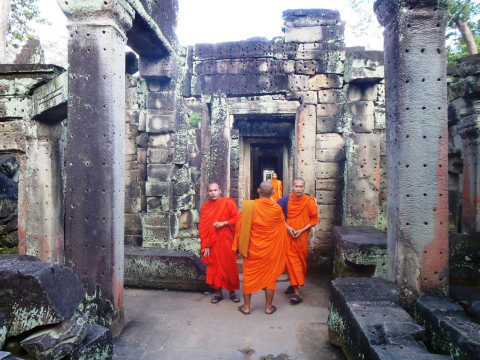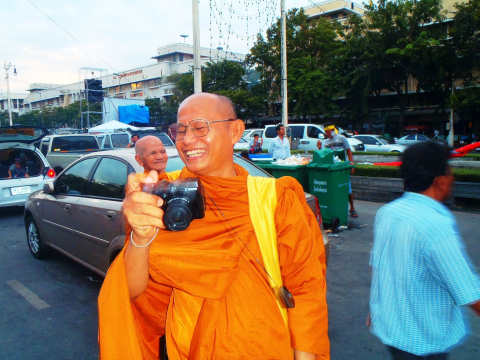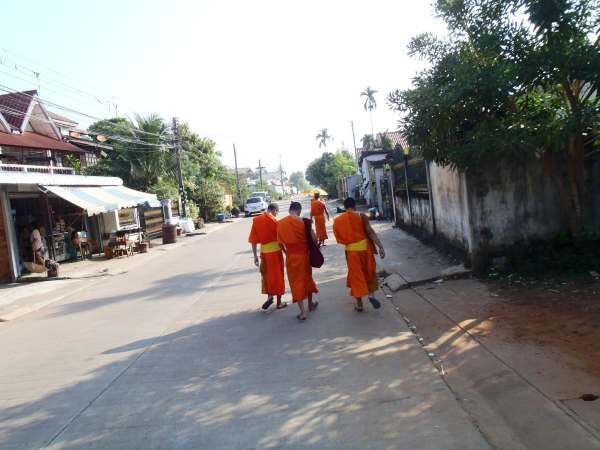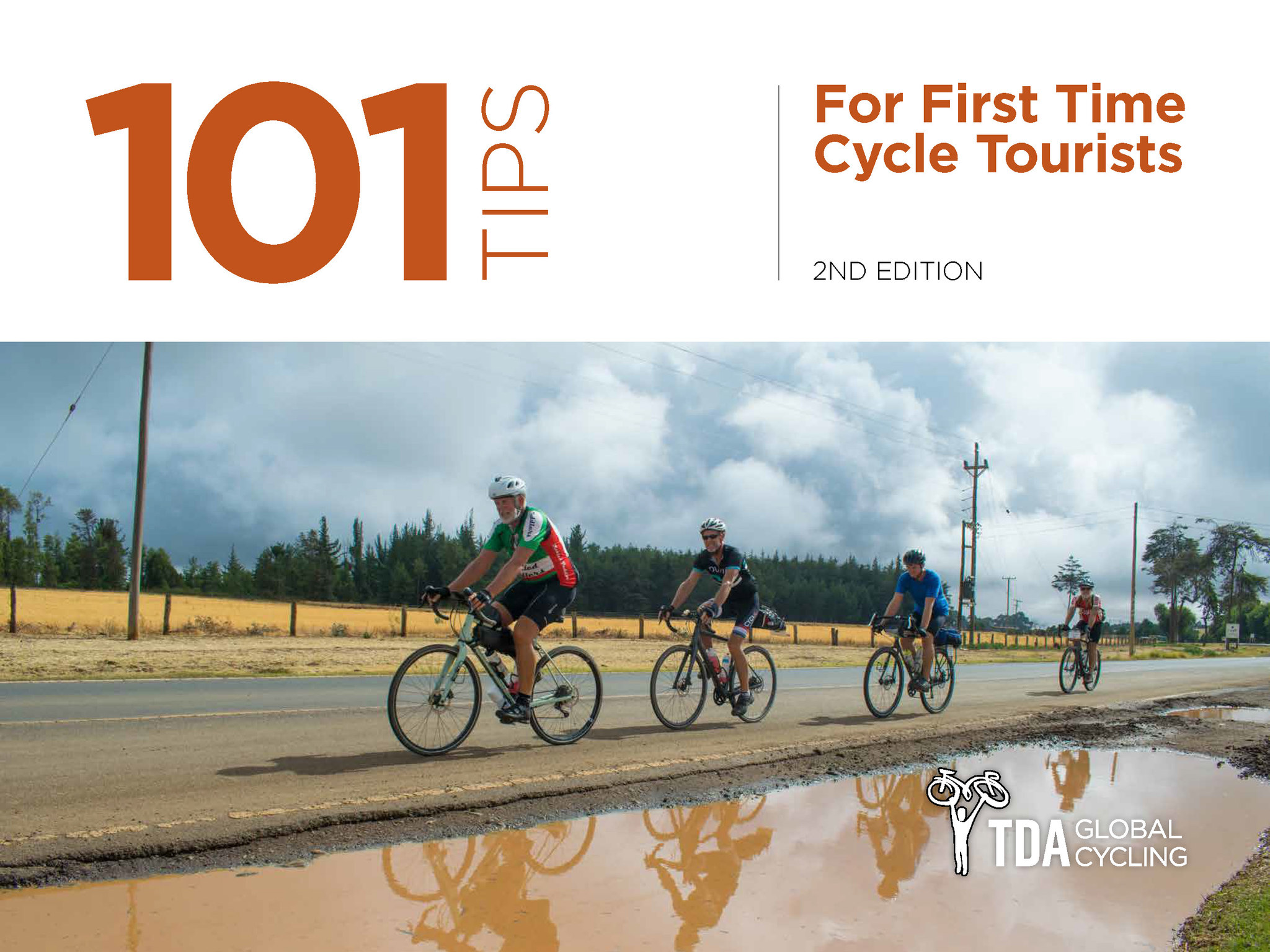Blog
The Bamboo Road from a Buddhist Perspective
As we cycle south through north Vietnam, into Lao and Cambodia there are increasing signs that ‘there be Buddhists here’—shrines and temples by the road, elegant Buddhas on hillsides, monks on their morning ‘alms round’, Buddhas of all shapes and sizes in the markets. These sights are one of the bonuses of ‘cycling head down, ass up’ for several hours a day as the trip includes hills, long stretches where the road virtually disappears then reappears every kilometer or so, blaring horns, 35C+ degree heat, dust, scooter and truck/bus exhaust, and much more. As a Buddhist might say, this trip offers an intense and focused opportunity to reflect on aspects of the dhamma. (The Dhamma denotes both Buddha’s teachings and the direct experience of nibbāna, the quality at which those teachings are aimed.) (1)
 Nibbana names the transcendent and singularly ineffable freedom that stands as the final goal of all the Buddha’s teachings.
Nibbana names the transcendent and singularly ineffable freedom that stands as the final goal of all the Buddha’s teachings.
Defined in terms of what it is… “This is peace, this is exquisite—the resolution of all fabrications, the relinquishment of all acquisitions, the ending of craving; dispassion; cessation; Nibbana.”
Two aspects of Buddhism – a Buddhist attitude of mind and the first noble truth – are referenced in this article.
Buddhist Attitude of Mind
 The Buddha claimed no inspiration from any god or external power … Only a woman or a man can become Buhddha. We all have within ourselves the potential to become a Buddha, if only we work at it. Within Buddhism we are recognized as being our own masters. There is no higher being or power that sits in judgment over our destiny. (2) Applied to the terms of this trip, it means, no “whining” or complaining about others for the way things are, especially when they’re not the way we think they should be.
The Buddha claimed no inspiration from any god or external power … Only a woman or a man can become Buhddha. We all have within ourselves the potential to become a Buddha, if only we work at it. Within Buddhism we are recognized as being our own masters. There is no higher being or power that sits in judgment over our destiny. (2) Applied to the terms of this trip, it means, no “whining” or complaining about others for the way things are, especially when they’re not the way we think they should be.
First Noble Truth
 There is the presence of suffering (or ‘dukkha in pali’, incapable of satisfying, not able to bear or withstand anything: always changing, incapable or making us truly happy)—“birth is suffering, aging is suffering, sickness is suffering, disassociation from the loved is suffering, not getting what one wants is suffering …. (3)
There is the presence of suffering (or ‘dukkha in pali’, incapable of satisfying, not able to bear or withstand anything: always changing, incapable or making us truly happy)—“birth is suffering, aging is suffering, sickness is suffering, disassociation from the loved is suffering, not getting what one wants is suffering …. (3)
We can add cycling to this list. Well, given that we’ve all put time, energy and money into being here, let’s realistically call cycling the ‘little suffering’. It’s rather mild in the broad scheme of things.
According to Sumedho, to let go of suffering we need to ‘admit it into consciousness’. Normally, suffering is not something we really want to focus on. Most of us have a tendency to deny it, or rationalize it away—no pain no gain—or power our way through the difficult parts.
Until we learn how to watch the mind in the right way we suffer unnecessary fear and anxiety from the endless changing conditions within and around us. … Watch your heart, observe. Be the knower, not the condition. Mindfulness is the escape hatch (i.e., from suffering). (4)
Admitting the daily dissatisfactions of the trip (e.g., being less than happy with our accommodations, or uncertain about what lies down the road, or put off by our fellow riders, or the morning rush of getting ready to ride) and so on into our consciousness is one way to practice the first noble truth—“there is suffering, it should be understood and finally, it has been understood” (Sumedho). Reflecting in this manner can also highlight what a trip like this involves in terms of “little suffering”.

Two Examples
• Starting the day. For many riders, especially in the beginning portions of the trip, getting ready to ride was/is a source of tension. There’s a lot to do in a short time—pack bags and get them to the truck, dress and inventory aches and pains, eat breakfast, check bicycle, fill water bottles … . After a couple of weeks things feel more calmed. Riders appear less stressed, more relaxed and this includes me. The remaining sore point seems to be breakfast, its quantity, quality and timeliness. Many of us still ‘jump the gun’ in our rush to finish breakfast and get on the road. Is being calm through all this and maintaining a snippet of equanimity (unshakable balance of mind, rooted in insight) practicing Buddhism? Perhaps, but admitting these associated tensions into our consciousness sure helps.
• Dealing with expectations. Or rather dealing with our reactions when things don’t work out the way we expect doesn’t correspond to our expectations or the way things ‘should be’. It’s not an ‘either or’ thing as we need expectation to prepare for each day, e.g., how far is the ride; where are the turns; how will we know we’re on the right road; are their any hills and on which part of the route?
 A couple of days back a number of riders were led to believe that the upcoming day’s ride would be reasonably smooth. This turned out not to be the case, and big time! The road was a mess of dirt, dust, potholes and broken pavement for kilometers on end. This made things much more difficult what with the dust, having to be constantly on the alert for rocks and holes and all manner of vehicles searching for places to pass. Some riders were somewhat miffed as they felt mislead and that the road conditions should have been made much clearer. This all came to a head at the next day’s rider meeting. I’m not sure how things turned out or whether any resolution was achieved. A number of riders were matter-of-fact about taking things as they were —time to move on. The road was the road and knowing in advance how bad it was wasn’t going change what it took to ride the day. As the popular saying goes, “It is what it is.”
A couple of days back a number of riders were led to believe that the upcoming day’s ride would be reasonably smooth. This turned out not to be the case, and big time! The road was a mess of dirt, dust, potholes and broken pavement for kilometers on end. This made things much more difficult what with the dust, having to be constantly on the alert for rocks and holes and all manner of vehicles searching for places to pass. Some riders were somewhat miffed as they felt mislead and that the road conditions should have been made much clearer. This all came to a head at the next day’s rider meeting. I’m not sure how things turned out or whether any resolution was achieved. A number of riders were matter-of-fact about taking things as they were —time to move on. The road was the road and knowing in advance how bad it was wasn’t going change what it took to ride the day. As the popular saying goes, “It is what it is.”
 Again, as in the example above, does being ‘one with the road’ constitute practicing Buddhism? Is being aware of tensions created by a gap between our expectations and reality helpful in freeing us from the “little suffering” resulting from unmet expectations? Maybe yes; maybe no, but reflecting on this and other similar incidents provides a place to begin.
Again, as in the example above, does being ‘one with the road’ constitute practicing Buddhism? Is being aware of tensions created by a gap between our expectations and reality helpful in freeing us from the “little suffering” resulting from unmet expectations? Maybe yes; maybe no, but reflecting on this and other similar incidents provides a place to begin.
This article is by a rider on the Bamboo Road trying to understand a little more about the first noble truth of Buddhism.
1) A Glossary of Pali and Buddhist Terms. 2005 (http://www.accesstoinsight.org/glossary.html#d)
2) Walpola Rahula. What the Buddha Taught. (adapted)
3) Ajahn Sumedho. Four Noble Truths. Buddha Dharma Education Association. Inc.
4) Ajahn Sumedho. “The Dharma Is Right Here.” In Seeing the Way: discerning timeless truth in traditional Buddhist teaching. Aruna Publications. 2011
— Paul Tomlinson
 REGISTER NOW
REGISTER NOW




1 Comment for "The Bamboo Road from a Buddhist Perspective"
Beautiful post, Paul. Well digested and explained.
Thanks